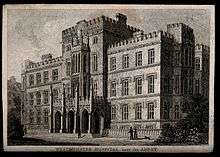Westminster Hospital


Westminster Hospital was a hospital in London, England, founded in 1719. In 1834 a medical school attached to the hospital was formally founded. In 1939 a newly built hospital and medical school opened in Horseferry Road, Westminster. In 1994 the hospital closed, and its resources were moved to the new Chelsea and Westminster Hospital at the old St Stephen's Hospital site in Fulham Road.
History

The Westminster Hospital was established in 1719 as a charitable society "for relieving the sick and needy at the Public Infirmary in Westminster", and promoted by Mr Henry Hoare (1677–1725), otherwise "Henry the Good", son of Sir Richard Hoare and a Partner in the bank C. Hoare & Co, and his associates. The hospital was rebuilt in 1832 with help from Charles Hoare (great-grandson of 'Good' Henry Hoare). It was the first subscription hospital erected in London, and was incorporated in 1836.[1]
In 1720, a house was taken for the purpose of an infirmary in Petty France; from which, in 1724, the institution was removed to Chapel Street, and some time after to James Street. A new and spacious hospital building was completed and opened in 1834, of an embattled quasi-Gothic character, erected by Messrs. Inwood. The hospital was situated by the Broad Sanctuary and the northern side of the nave of Westminster Abbey, between the Sessions House and Victoria Street, and accommodated about 200 in-patients, and the total number of patients relieved annually, in an 1878 account, was about 20,000. According to the same 1878 description, "Patients are admitted by order from a governor, except in cases of accident, which are received, without recommendation, at all hours of the day or night".[1]
The following document, which may be styled the first annual report of this institution, dated 1720, hung framed and glazed on the wall of the secretary's room as at about 1878:
- "Whereas a charitable proposal was published in December last (1719), for relieving the sick and needy, by providing them with lodging, with proper food and physick, and nurses to attend them during their sickness, and by procuring them the advice and assistance of physicians or surgeons, as their necessities should require; and by the blessing of God upon this undertaking, such sums of money have been advanced and subscribed by several of the nobility and gentry of both sexes and by some of the clergy, as have enabled the managers of this charity (who are as many of the subscribers as please to be present at their weekly meetings), to carry on in some measure what was then proposed:—for the satisfaction of the subscribers and benefactors, and for animating others to promote and encourage this pious and Christian work, this is to acquaint them, that in pursuance of the foresaid charitable proposal, there is an infirmary set up in Petty France, Westminster, where the poor sick who are admitted into it, are attended by physicians, surgeons, apothecaries, and nurses, supplied with food and physick, and daily visited by some one or other of the clergy; at which place the society meets every Wednesday evening for managing and carrying on this charity, admitting and discharging patients, &c."[1]
Malvina Longfellow (1889–1962), a silent movie actress of the 1920s, died at the Hospital on 2 November 1962, having been admitted from her flat in South Street, Mayfair.[2]
The Conservative Member of Parliament Airey Neave died at the hospital on 30 March 1979, after being badly wounded by a car bomb as he drove out of the nearby House of Commons that day.[3]
Ernest Tidyman, American author of Shaft and Academy Award winning screenwriter of The French Connection, also died in Westminster Hospital on July 14, 1984 of a perforated ulcer and complications. Tidyman was in London for a production meeting about a film to be made in Europe.[4]
See also
References
- 1 2 3 Westminster: King St, Great George St and the Broad Sanctuary in Old and New London: Volume 4 (1878), pp. 26-35, from British History Online
- ↑ "Cunliffe, Malvina Virginia", in Probate Index for 1962 at probatesearch.service.gov.uk, accessed 6 August 2016
- ↑ "Airey Neave assassinated". The Guardian. 31 March 1979. Retrieved 26 April 2011.
- ↑ "ERNEST R. TIDYMAN, SCREEN WRITER, DIES AT 56". The New York Times. July 16, 1984. Retrieved 31 December 2014.
Coordinates: 51°30′00″N 0°07′45″W / 51.5000°N 0.1291°W